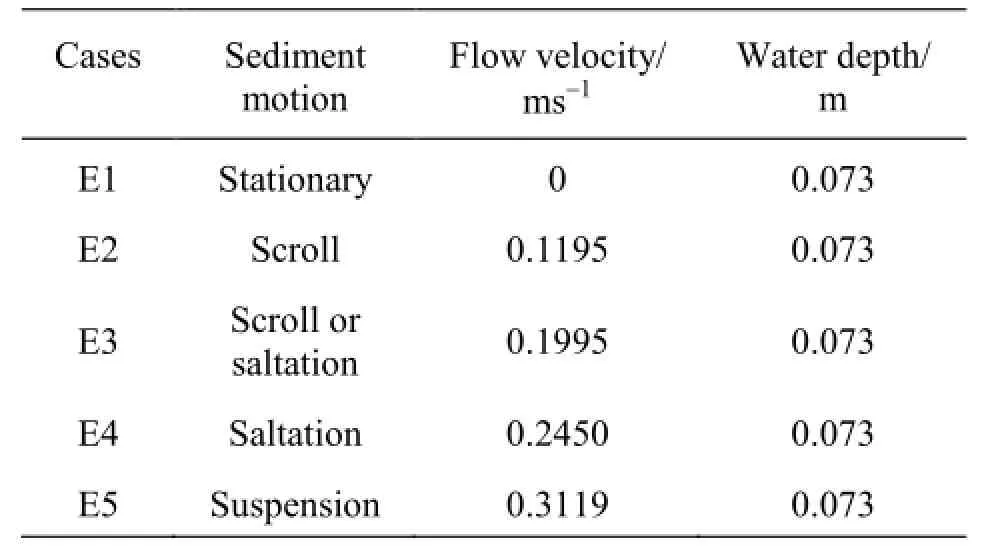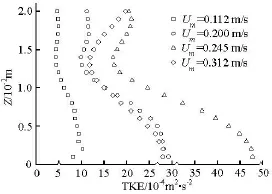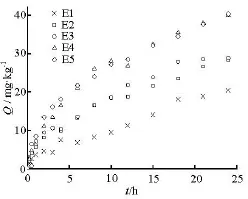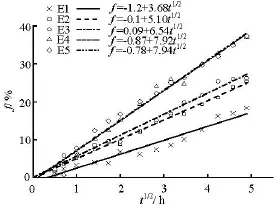Effects of water flow on the uptake of phosphorus by sediments:An experimental investigation*
Yang XIAO (肖洋),Hao-ke CHENG (成浩科),Wei-wei YU (余维维),Zhi-wei LI (李志伟)
1.State Key Laboratory of Hydrology-Water Resources and Hydraulic Engineering,Hohai University,Nanjing 210098,China
2.College of Water Conservancy and Hydropower Engineering,Hohai University,Nanjing 210098,China,E-mail:sediment_lab@hhu.edu.cn
Effects of water flow on the uptake of phosphorus by sediments:An experimental investigation*
Yang XIAO (肖洋)1,2,Hao-ke CHENG (成浩科)2,Wei-wei YU (余维维)2,Zhi-wei LI (李志伟)1,2
1.State Key Laboratory of Hydrology-Water Resources and Hydraulic Engineering,Hohai University,Nanjing 210098,China
2.College of Water Conservancy and Hydropower Engineering,Hohai University,Nanjing 210098,China,E-mail:sediment_lab@hhu.edu.cn
This paper investigates the effect of the water flow on the phosphorus uptake by sediments.Five experiments with different overlying flow velocities are carried out in an annular flume.The results show that the water flow significantly affects the phosphorus uptake by sediments.The sediment motion could be stationary,scroll,scroll or saltation,saltation and suspension under different flow conditions.The minimum amount of the phosphorus uptake is observed where the sediment motion is stationary.The uptake capacity of phosphorus increases with the increase of the flow velocity.However,there is no apparent difference in the uptake capacity of phosphorus between the saltated and suspended sediments.The uptake rate of phosphorus by sediments in the laboratory flume experiments is much lower than the adsorption rate in the batch experiments.There is a linear relationship between the amount of phosphorus uptake by sediments and the square root of time.
water flow,phosphorus,uptake,flume
In rivers,phosphorus transports downstream either in the soluble form with water or in the particulate form attached to the sediment.The ultimate fate of phosphorus is closely related to the sediments.For example,over 90% of phosphorus in the Yangtze River is in the particulate form[1].
Previous researches mostly focused on the factors affecting the adsorption and the desorption of the contaminant by sediments,such as the properties of the sediment,the contaminant and the environmental medium[2,3].These studies were mainly conducted in batch reactors where the conditions were quite different from those in natural rivers.In rivers and lakes,thesediments move on or near the bed and the movements can be divided into rolling,sliding,jumping and suspending as the flow velocity increases.The uptake of phosphorus by sediments is significantly affected by various sediment motions[4-6].But,the mechanism of the effect of the water flow on the phosphorus uptake by sediments remains not very clear.
Five independent experiments with different flow velocities corresponding to five sediment motions(stationary,scroll,scroll or saltation,saltation and suspension) are carried out.These experiments are conducted in a modified flume to simulate a river system.The sediments are collected from the Nanjing reach of the Yangtze River.The flow structures in the flume are measured by the acoustic Doppler velocimetry(ADV).
KH2PO4is added into the flume to obtain an initial concentration of phosphorus of 5mg/L.400 g sediments are placed evenly on the bottom of the flume to form a layer of about 0.003 m in thickness.Water samples are collected at 0 h,0.25 h,0.5 h,1 h,2 h,3 h,4 h,6 h,8 h,10 h,12 h,15 h,18 h,21 h and 24 h and then analyzed for the SRP by the molybde-
num-blue method.After each sampling,an equivalent water volume containing an appropriate phosphorus concentration is supplemented.In the meantime,the flume is supplemented with the distilled water to replace any evaporation losses at an interval of 3 h.The quantity of the phosphorus uptake by sediments is calculated by the changes of the concentration of phosphorus in the water column.

Table 1 Experimental conditions
Table 1 lists the details of experimental conditions.The five cases of the flow velocity corresponding to five different sediment motions are determined by the combination of the theoretical formula and the experimental observation.

Fig.1 The distribution of TKE along vertical direction at different flow velocities
Figure 1 shows the turbulence kinetic energy(TKE) of the flow,as expressed by

whereu′,v′,w′are the turbulence intensities inx,y,zdirections.The values of the TKE increase with the increase of the flow velocity in the Cases of E2,E3 and E4.The TKE value in the Case E5 is smaller than that in the Case E4.It is because the suspended sediment would inhibit the turbulence intensity[7].
Figure 2 shows the amount of phosphorus uptake by per unit mass of sediments at different flow velocities.

Fig.2 The amount of phosphorus uptake by sediments over time at different flow velocities
In all cases,the amount of phosphorus uptake by sediments increases significantly over time.The amount of phosphorus adsorbed by sediments ranges from 20.4 mg/kg to 40.35 mg/kg.In our previously research[8]the maximum phosphorus adsorption capacity of sediments ranges from 352 mg/kg to 803 mg/kg.This means that the net uptake of phosphorus by sediments in the flume system is in a state far from a steady-state equilibrium at the end of experiment.The minimum phosphorus uptake capacity is observed at a velocity of 0 m/s.With the increase of the flow velocity,the amount of phosphorus uptake increases.Similar phenomenon was observed by Zhang et al.[9],who found that the dynamic release of the TP of the re-suspension sediment is 6 times higher than the static release.Several factors may contribute to this result:(1) the concentration of the dissolved oxygen in the overlying water increases with the increase of the turbulence,which creates a higher redox potential and the oxidation of the soluble Fe2+into Fe3+could accelerate the adsorption of phosphorus by sediments[10,11],(2) as the flow velocity increases,the phosphorus uptake by bed sediments increases in response to the depth of the boundary layer[12],(3) the increased concentration of the suspended sediment increases the collision probability between the sediments and the phosphorus particles,which is favorable to the phosphorus adsorption.
It is interesting to note that there is no apparent difference between the data in the Cases E4 and E5 despite the differences of the flow conditions and the sediment motion are noticeable.This result is probably due to the compromise of the decrease of the TKE and the increase of the suspended sediment concentration.

Fig.3 Variations of phosphorus uptake rate(K)over time for different motions of sediments (taking E1,E3,E5 for instance)
Figure 3 shows the variation of the phosphorus uptake rate(K)over time in different cases (taking E1,E3,E5 for instance).The value ofK is calculated as follows

where Qt2and Qt1are the amounts of phosphorus uptake by sediments at times t2and t1,respectively.It is obvious that the phosphorus uptake rate decreases with the time in all five cases.The largest uptake rate appears in the first 1 h.This phenomenon may be attributed to the frequent exchange between the bed sediments and the suspended sediments in the early stage of E5,which is favorable to the adsorption of phosphorus by sediments.There is a clear distinction between the uptake rate of phosphorus in the batch experiments and the flume experiments.In our previously research[8],the adsorption rate of phosphorus by sediments is 30 mg/(kg·h)-50 mg/(kg·h),which is much higher than the uptake rate whose the maximum value is 17.47 mg/ (kg·h) in the flume experiments.

Fig.4 Variations of phosphorus fraction in sediments over time.The lines are the regression lines,and symbols are experimental data
The phosphorus fraction in sedimentsfis defined asf=mb/ma,where mbis the amount of phosphorus uptake by sediments,mais the total amount of phosphorus in the water column.Three mechanisms are attributed to the phosphorus uptake by sediments:(1) phosphorus adsorbed by the suspended sediments,(2) the diffusion process of phosphorus from the overlying water into the pore water because of the concentration gradient,(3) the adsorption and desorption process of phosphorus in the pore water by bed sediments.Figure 4 shows the variation of phosphorus fraction f over time at different flow velocities.It is noted that there is a linear relationship between fand t1/2,which may be expressed as

where R and B are constants.The adj-R2value ranges from 0.95-0.99,which suggests a reasonable fit to the data.It enables a single parameter R to be assigned to the rate of phosphorus uptake.There is a positive relationship between the value of R and the flow velocity.
In summary,the phosphorus uptake by sedimentsin the flume experiments is in a state far from a steady equilibrium at the end of the experiments.The minimum amount of phosphorus uptake is observed when the sediment is stationary and the uptake capacity of phosphorus increases with the increase of the flow velocity.The uptake rate of phosphorus in the flume experiments is much smaller than the adsorption rate of phosphorus in the batch experiments.Moreover,there is a linear relationship between the phosphorus fraction in the sediments and t1/2.
[1]DUAN Shui-wang,ZHANG Shen and CHEN Xiao-bao et al.Concentrations of nitrogen and phosphorus and nutrient transport to estuary of the Yangtze river[J].Environmental Science,2000,21(1):53-56(in Chinese).
[2]MENG J.,YAO Q.and YU Z.Particulate phosphorus speciation and phosphate adsorption characteristics associated with sediment grain size[J].Ecological Engineering,2014,70(5):140-145.
[3]ZHOU A.TANG H.and WANG D.Phosphorus adsorption on natural sediments:Modeling and effects of pH and sediment composition[J].Water Research,2005,39(7):1245-1254.
[4]ZHU Hong-wei,CHENG Peng-da and ZHONG Baochang et al.The mechanisms of contaminants release due to incipient motion at sediment-water interface[J].Science China Physics,Mechanics and Astronomy,2014,57(8):1563-1568.
[5]LIANG D.,WANG X.and EVANS B.et al.Study on nutrient distribution and interaction with sediments in a macro-tidal estuary[J].Advances in Water Resources.2013,52(2):207-220.
[6]LINDA H.K.,WILLIAM R.M.and MICHAEL H.B.The release of dissolved nutrients and metals from coastal sediments due to resuspension[J].Marine Chemistry,2014,121(5):224-235.
[7]LIU Qing-quan,CHEN Li.Further analysis of the effect of particles on flow turbulence[J].Journal of Hydraulic Engineering,1997,(9):77-82(in Chinese).
[8]XIAO Y.,CHENG H.and ZHU X.et al.Experimental study on adsorption of phosphorus on sediment components with different particle sizes[J].Environmental Engineering and Management Journal.2015,14(10):2493-2499.
[9]ZHANG Kun,CHENG Peng-da and ZHONG Bao-chang et al.Total phosphorus release from bottom sediments in flowing water[J].Journal of Hydrodynamics,2012,24(4):589-594..
[10]JARVIE H.P.,JÜRGENS M.D.and WILLIAMS R.J.et al.Role of river bed sediments as sources and sinks of phosphorus across two major eutrophic UK river basins:The Hampshire Avon and Herefordshire Wye[J].Journal of Hydrology.2005,304(1-4):51-74.
[11]FAN Jing-yu and WANG Dao-zeng.Experimental investigation on diffusive contaminant release from permeable sediment layer under unidirectional unsteady flow[J].Journal of Hydrodynamics,2014,26(6):965-970.
[12]HOUSE W.A.,DENISON F.H and SMITH J.T.et al.An investigation of the effects of water velocity on inorganic phosphorus influx to a sediment[J].Environmental Pollution,1995,89(3):263-271.
10.1016/S1001-6058(16)60636-4
(Received December 19,2015,Revised March 25,2016)
* Project supported by the National Natural Science Foundation of China (Grant Nos.51179055,51239003),the Special Fund for Public Welfare of Water Resources Ministry(Grant No.201501007).
Biography:Yang XIAO (1974-),Male,Ph.D.,Professor
2016,28(2):329-332
- 水动力学研究与进展 B辑的其它文章
- Manoeuvring prediction based on CFD generated derivatives*
- Calculation of tip vortex cavitation flows around three-dimensional hydrofoils and propellers using a nonlinear k -ε turbulence model*
- Hull form optimization of a cargo ship for reduced drag*
- Numerical simulation of self-similar thermal convection from a spinning cone in anisotropic porous medium*
- An axisymmetric model for draft tube flow at partial load*
- An iterative re-weighted least-squares algorithm for the design of active absorbing wavemaker controller*

